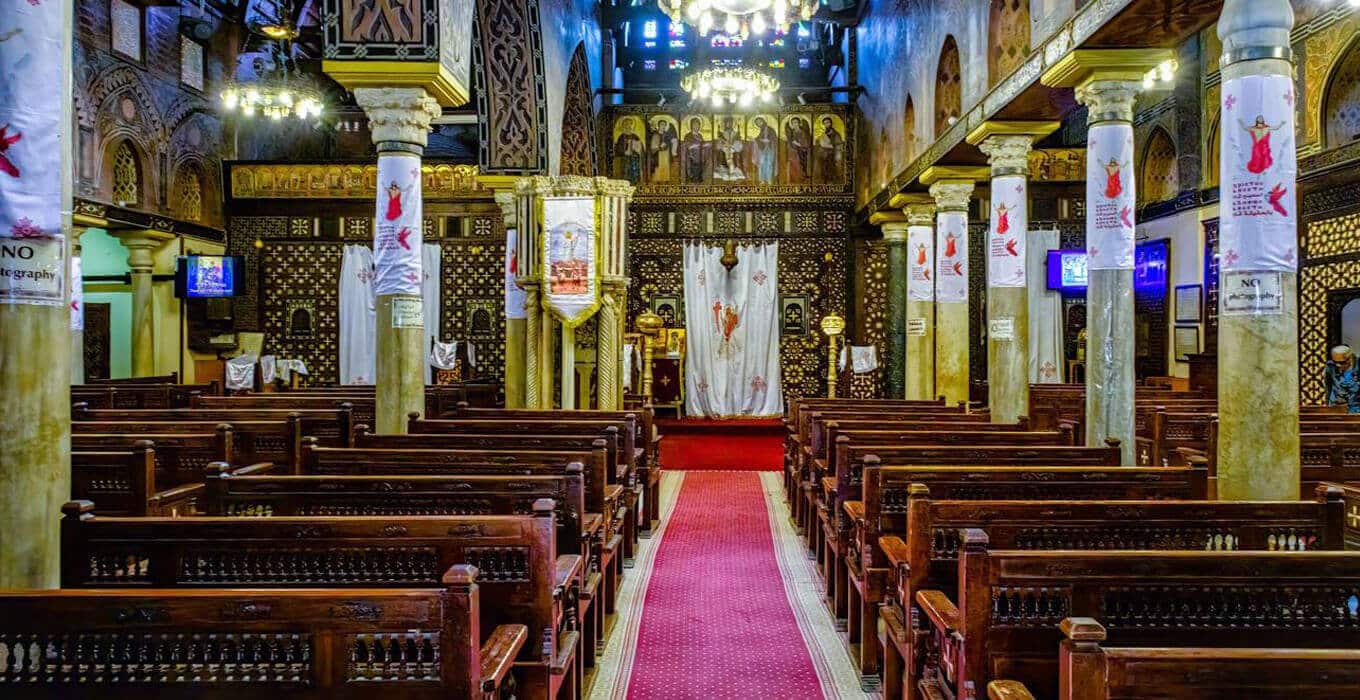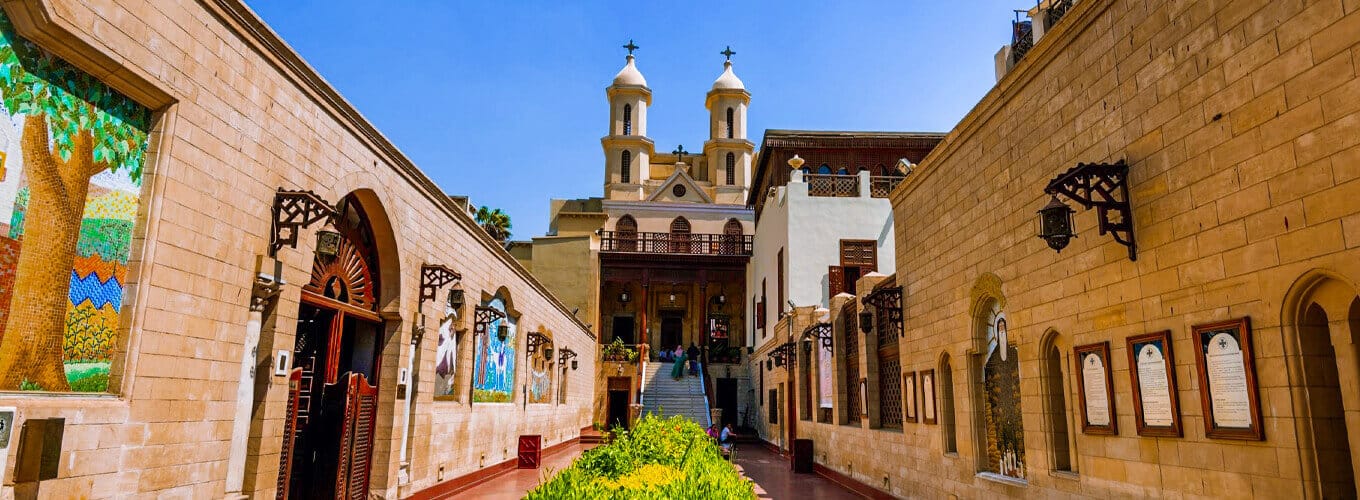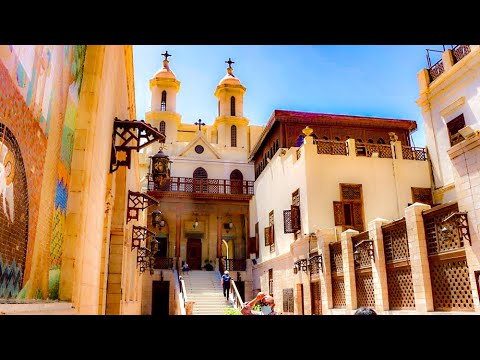In the heart of Old Cairo lies a hidden gem, the Hanging Church in Cairo. It’s also known as the Coptic Cairo Church of the Virgin Mary. This amazing church dates back to the 3rd century AD. It shows Egypt’s deep Coptic Christian roots and is a must-see for those wanting to dive into the country’s spiritual and cultural world. But what makes the Hanging Church so special and intriguing? Get ready to explore the secrets and wonders of this ancient Coptic treasure.
Key Takeaways
- The Hanging Church in Cairo is one of the oldest churches in Egypt, dating back to the 3rd century AD.
- The church is built atop the south gate of the Roman Fortress of Babylon, showcasing its ancient origins and historical significance.
- The Hanging Church’s unique architectural design, being suspended over the original ground level, adds to its distinctive appearance and charm.
- The Hanging Church is considered an essential site for Coptic Christians and serves as the seat of the Coptic Orthodox Pope of Alexandria.
- Restoration efforts have been undertaken to preserve the Hanging Church, ensuring its continued function as a place of worship and tourist attraction.
Unveiling the History of the Hanging Church
The Hanging Church, also known as the Suspended Church or Al-Mu’allaqah Church, is very old. It dates back to the 3rd century AD. It sits on top of a Roman fortress gatehouse. This shows the long history of Coptic Christianity in the area.
The Hanging Church’s Unique Architecture
This church stands out because it’s high up. It seems to hang over the ground below. This was done to keep it safe from floods and to offer a strong defense.
Over time, the church has been changed and updated. It now shows off styles from ancient Egypt, Byzantium, and Islam. This mix makes it a key historical and cultural spot.
Exploring the Rich Christian Heritage
The Hanging Church is a symbol of Coptic Christianity in Egypt. It’s one of the oldest churches here. Visitors can see how deep the religious roots go in the area.
Its special spot and design show how the Coptic Christians have survived tough times. They’ve seen many changes in Egypt’s history.
Today, the Hanging Church is a top spot for those interested in religion and history. People come to learn about Cairo’s Coptic Christian past.
The Hanging Church in Cairo: A Glimpse into Coptic Roots

The Hanging Church of Cairo is a key symbol of the Coptic Christian faith. It’s also known as the Suspended Church or Al-Mu’allaqah. Built in the 3rd century AD, it shows the long history of Coptic Christians in the city.
This church is a major site for Coptic Christians in Cairo. It has been important for their history and spiritual life. The Hanging Church is a must-see for anyone interested in the Coptic faith.
The Hanging Church is in Old Cairo, surrounded by history. It combines ancient Egyptian and Byzantine styles. Its design, with a wooden roof like an ark, and colorful icons, shows the mix of art and faith in Coptic Christianity.
Over the years, the church has been rebuilt several times. This shows the effort to keep this important cultural and religious site safe. Since the 11th century, it has been the home of the Coptic Orthodox Pope in Cairo.
Next to the Hanging Church is the Coptic Museum. It has lots of Coptic art and artifacts. Visitors can learn a lot about the Copts’ culture and early Christian history here.
The museum has many exhibits, like textiles, icons, manuscripts, and sculptures. These items show the artistic and religious traditions of the Coptic people.
Visiting the Hanging Church and Coptic Cairo lets you dive into the Coptic Christian world. You’ll see amazing architecture and learn about their culture. It’s a special way to connect with one of the oldest Christian communities in the world.
Discovering Coptic Cairo: A Spiritual Journey
Starting with the Hanging Church in Cairo opens a spiritual journey through Coptic Cairo. This area is full of sacred sites, each with its own story. The Hanging Church of Cairo, also known as the Al-Mu’allaqah Church, is just the start.
The Surrounding Sacred Sites
There’s more to see in Cairo’s Coptic Christian heritage. Places like the Amr Ibn Al-Aas Mosque and the Ben Ezra Synagogue are close by. They show how different religions have lived together in the city for years.
Blending Architectural Styles
The Hanging Church is a mix of many cultures. It has an ancient Egyptian, Byzantine, and Islamic look. This shows the rich mix of Cairo’s Coptic heritage and Cairo’s historical churches.
Visitors will see how different religions have shaped Coptic Cairo. They’ll learn about Ancient Egyptian Christianity and the lasting impact of Coptic Cairo’s iconic landmarks.
| Surrounding Sacred Sites | Opening Hours | Entrance Fee |
| Amr Ibn Al-Aas Mosque | Open daily | Free |
| Ben Ezra Synagogue | Saturday to Thursday, 9:00 AM to 4:00 PM | Free |
| Saints Sergius and Bacchus Church | Open 24/7 | Free |
| St. Barbara’s Church | Daily, morning to afternoon | Free |
| Church of St. George | Daily, 9:00 AM to 5:00 PM | Free with donation |
| Saint Mercurius Church | Daily, 9:00 AM to 5:00 PM | Free |
| Coptic Museum | Daily, 9:00 AM to 5:00 PM | 120 EGP for international visitors, 60 EGP for Egyptian residents |
Visiting the Hanging Church: A Timeless Experience
Walking into the Hanging Church of Cairo feels like going back in time. The air is filled with the scent of Coptic Christian history and the sound of old prayers. This famous church is still a place of worship, drawing visitors from all over the world.
Even after many years, the Hanging Church has been fixed up. Now, it’s a safe spot for both tourists and those who go there to pray. You can see its detailed design, holy items, and the old sites around it. This connects you to the long traditions and tales of Coptic Cairo.
The church sits above the Babylon Fortress, giving it a unique look. Inside, you’ll see a wooden roof like Noah’s Ark and a marble pulpit with 13 columns. These symbolize Jesus and his followers, making it a sight to behold.
In the quiet of the early morning, the church is peaceful and perfect for taking in its beauty. You’ll see beautiful carvings, elegant arches, stunning frescoes, and gold art. Each part of the Hanging Church shows the skill and hard work of its Coptic Christian builders.
If you love history, religious buildings, or just want a deep cultural experience, visiting the Hanging Church of Cairo is a must. It’s a journey into the spiritual and artistic soul of Coptic Cairo.
Hanging Church of Cairo: A Symbol of Religious Coexistence
The Hanging Church, also known as the Al-Mu’allaqah Church, is a symbol of Cairo’s history of religious peace. It is surrounded by other important religious places. This Coptic Christian church reminds us of Cairo’s ability to welcome different faiths and live in peace.
The Amr Ibn Al-Aas Mosque
Close to the Hanging Church is the Amr Ibn Al-Aas Mosque, one of Egypt’s oldest mosques. Being near the Hanging Church shows how Coptic Christianity and Islam have lived together in Cairo for a long time.
The Ben Ezra Synagogue
Also nearby is the Ben Ezra Synagogue, which has been restored to keep its Jewish heritage alive. These religious sites in Coptic Cairo show how the city values the peaceful living of different faiths.
This shows how Cairo’s people have learned to live together and succeed in a city full of different cultures. The Hanging Church, with its special design and deep history, is a symbol of this spirit of tolerance and understanding.
The Artistic Marvels of the Hanging Church
The Hanging Church in Cairo is more than just a building. It shows the amazing skill of its makers. Inside, you’ll see beautiful wooden carvings and bright frescoes. The main attraction is the ebony wood veil. It has detailed carvings and shows Christ on the throne.
There are also marble columns with fancy designs. These and the church’s unique design make it a special place to visit.
Intricate Wooden Carvings and Frescoes
The Hanging Church, or Church of the Virgin Mary, is very old, from the 7th century. It was rebuilt many times, with a big fix-up in the 10th century. In 1047, it became the home of the Coptic Orthodox Pope, showing its big role in the church.
Inside, there are 110 religious icons, some from the 18th century. The oldest is the Coptic Mona Lisa from the 8th century. The main altar is made of ebony with ivory and has designs from the 12th or 13th centuries.
The Hanging Church is a must-see for anyone wanting to learn about Coptic Christian history and art in Cairo.
Exploring the Depths: The Crypt and the Holy Family
Beneath the Hanging Church of Cairo, known as the Al-Mu’allaqah Church, is a crypt full of stories. It was thought to be a safe place for the Holy Family in Egypt. They hid here from the ruler of Palestine who wanted to harm the baby Jesus.
This crypt makes the Hanging Church even more special for Coptic Christians and visitors. Going down into the crypt connects you with the Coptic Christian tradition. It shows how the Hanging Church is important in Cairo’s culture and faith.
The crypt lets visitors see the Hanging Church’s deep Coptic Christian roots. It shows its role in Ancient Egyptian Christianity and religious tourism in Cairo. By learning about this hidden place, travelers can see the beauty of Cairo’s Coptic Heritage. They also see why the Hanging Church is a key landmark in the city.
Unveiling the Mysteries: The Hanging Church’s Historical Significance
The Hanging Church of Cairo is known as the Al-Mu’allaqah or the Church of the Virgin Mary. It has a deep history that goes beyond its stunning looks. This famous Coptic Christian site has been a key place for the area’s faith and culture for many years.
Patriarchal Seat and Burials
The Hanging Church is seen as the patriarchal seat, which is very important in the Coptic Christian faith. Many Coptic patriarchs have been buried here, making it a sacred place. These burials show how important Coptic Christianity is in Cairo and around.
Learning about the Hanging Church’s history helps visitors understand its big role in Cairo’s religious and cultural scene. It shows how Coptic Christian architecture has lasted through time. The Hanging Church is a symbol of the area’s rich and varied history.
“The Hanging Church is not just an architectural marvel, but a living embodiment of Coptic Christian history and tradition. Its significance as a patriarchal seat and burial site underscores the profound influence it has wielded over the centuries.”
Visiting the Hanging Church lets people see the lasting impact of Coptic Christianity in Cairo. This impact still shapes the city’s culture and spirit today.
Planning Your Visit: The Best Time to Explore
When you plan to see the Hanging Church of Cairo, also called the Al-Mu’allaqah Church, think about the best time. The summer is hot and hard to visit outdoor sites. The best times are from September to March, when it’s mild and less humid.
This lets you enjoy the church and Coptic Cairo more. Also, check if there are any special events or festivals during your visit. These can show you the Coptic Christian traditions and rituals.
The Hanging Church goes back to the 7th century. It’s a big part of Cairo’s Coptic heritage and Byzantine architecture.
- The Hanging Church was made the official home of the Coptic Orthodox Pope in 1047.
- Many patriarchs have been elected, enthroned, and buried here.
- The church is where the Virgin Mary appeared several times, including the Miracle of Mokattam Mountain in the 10th century.
Plan your visit in the best seasons and watch for special events. This way, you can dive deep into the Hanging Church of Cairo‘s history and spiritual meaning. It’s a key Coptic Christian site and shows the area’s ancient Egyptian Christianity and religious tourism.
Conclusion: Embracing the Magic of Cairo’s Hanging Church
Exploring the Hanging Church of Cairo, also known as the Al-Mu’allaqah Church, is a journey into the heart of the city’s Coptic Christian heritage. It shows off its unique suspended architecture and artistic marvels. The church also has a deep historical significance and spiritual ties, proving the lasting impact of Coptic Christianity in Egypt.
Visitors find more than just beauty at the Hanging Church. They learn about the coexistence of diverse faiths in Cairo. This experience lets them see how different beliefs have shaped the city’s culture. By exploring this Cairo’s iconic landmark, travelers get to know the city’s history and traditions.
The Hanging Church takes you into the world of Byzantine architecture and Coptic Christian history. It’s a peek into Cairo’s historical churches. This journey shows the beauty of ancient Egyptian Christianity in the church’s design and art. It highlights the importance of Cairo’s Coptic heritage in religious tourism.
Read our related articles:


